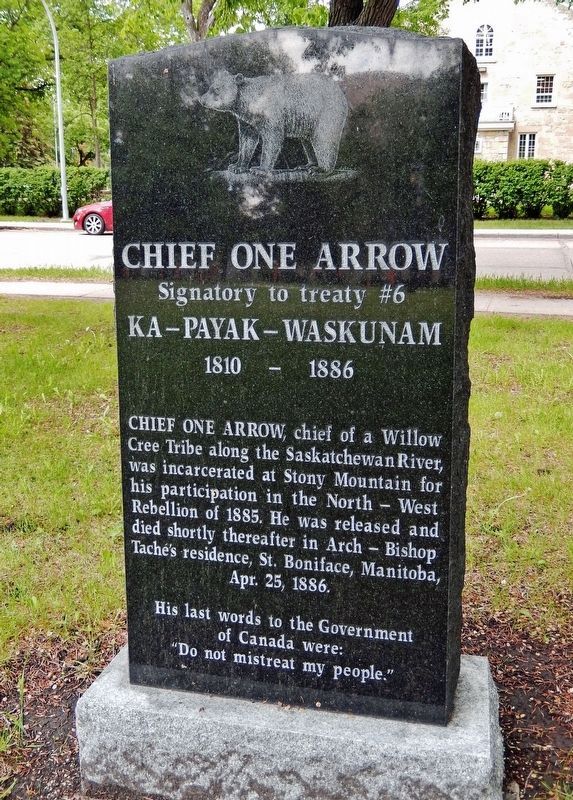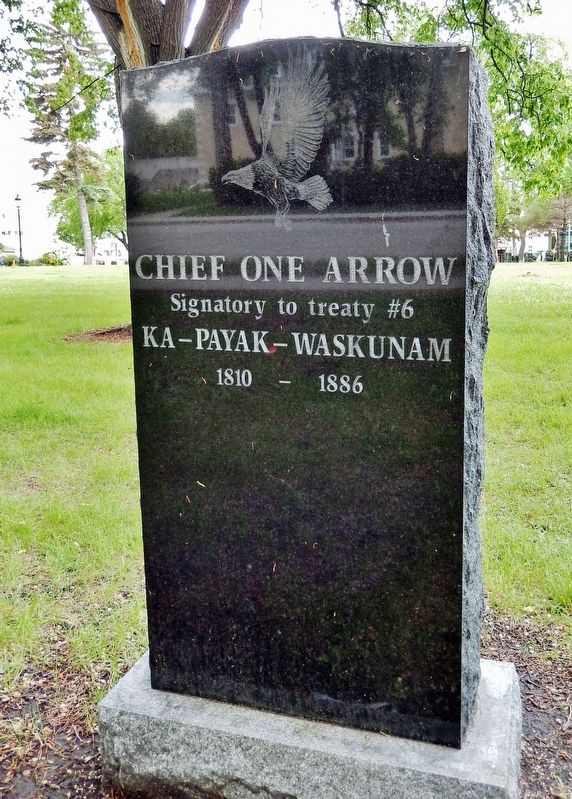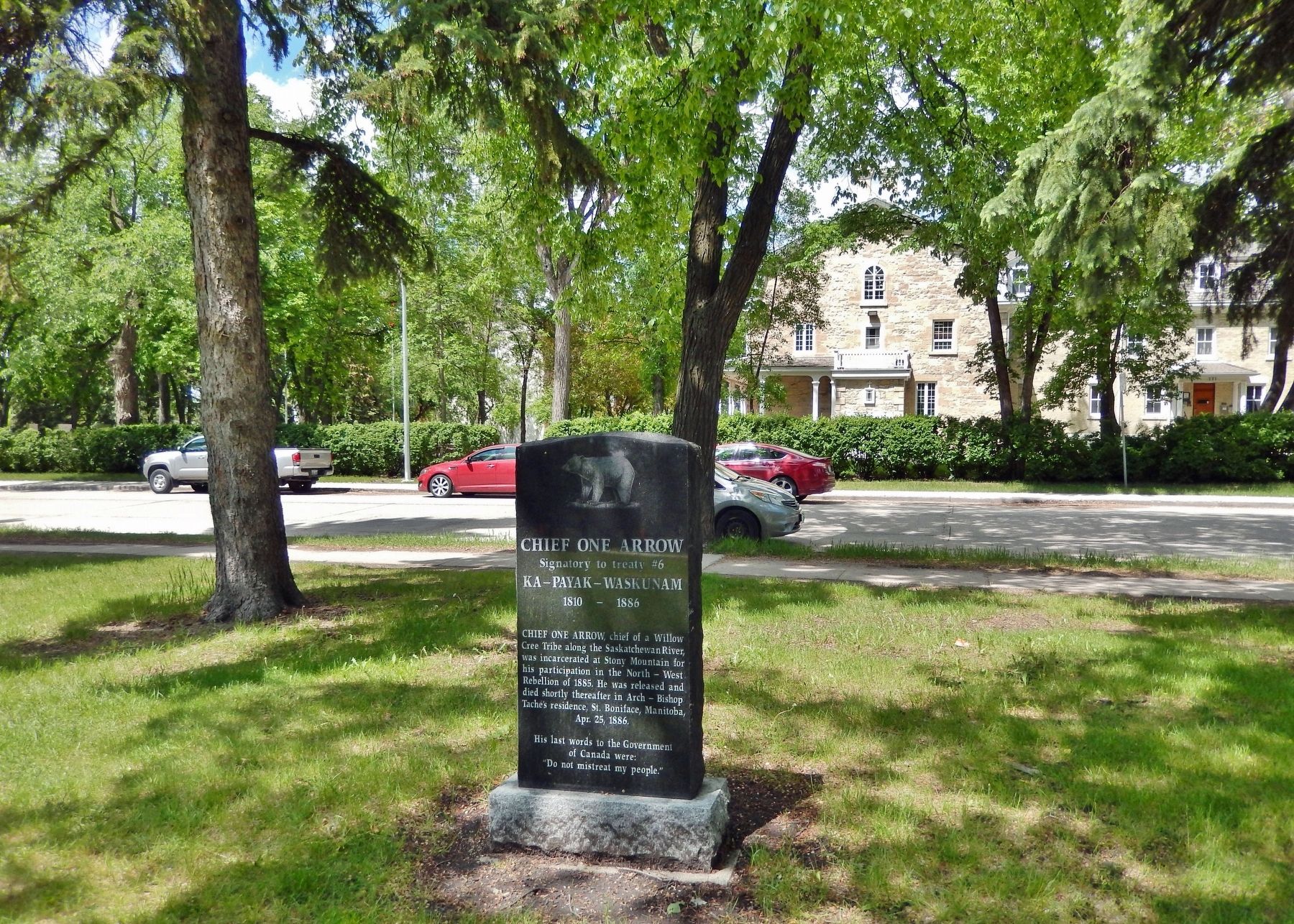Central St. Boniface in Winnipeg, Manitoba — Canada’s Prairie Region (North America)
Chief One Arrow
Ka-Payak-Waskunam
1810-1886
Chief One Arrow, chief of a Willow Cree Tribe along the Saskatchewan River, was incarcerated at Stony Mountain for his participation in the North-West Rebellion of 1885. He was released and died shortly thereafter in Arch-Bishop Taché’s residence, St. Boniface, Manitoba,
His last words to the Government
of Canada were:
”Do not mistreat my people.”
Topics. This historical marker is listed in these topic lists: Cemeteries & Burial Sites • Law Enforcement • Native Americans • Settlements & Settlers. A significant historical year for this entry is 1810.
Location. 49° 53.37′ N, 97° 7.376′ W. Marker is in Winnipeg, Manitoba. It is in Central St. Boniface. Marker is on Avenue de la Cathedrale just east of Tache Avenue, on the right when traveling east. Marker is located in the Saint Boniface Cathedral Cemetery. Touch for map. Marker is at or near this postal address: 180 Avenue de la Cathedrale, Winnipeg MB R2H 0H7, Canada. Touch for directions.
Other nearby markers. At least 8 other markers are within walking distance of this marker. Jean Baptiste La Vérendrye and Jean-Pierre Aulneau (within shouting distance of this marker); The Five Saint Boniface Cathedrals (within shouting distance of this marker); Les Soeurs Nolin / Nolin Sisters (about 180 meters away, measured in a direct line); Sister Marguerite d’Youville / Sœur Marguerite d’Youville (about 210 meters away); Le Couvent des Soeurs Grises / Grey Nuns' Convent (about 210 meters away); Joseph Royal (approx. 0.3 kilometers away); Forks of the Red and Assiniboine (approx. 0.4 kilometers away); The Creation of Manitoba (approx. 0.4 kilometers away). Touch for a list and map of all markers in Winnipeg.
Also see . . .
1. KĀPEYAKWĀSKONAM (Kah-pah-yak-as-to-cum, One Arrow, known in French as Une Flèche).
One Arrow was the chief of a band of Willow Crees which, until the disappearance of the buffalo from the Canadian prairies in the 1870s, traditionally hunted in the region bisected by the South Saskatchewan River. In 1876 he had been associated with other chiefs in an attempt to obstruct the negotiation of Treaty no.6 at Fort Carlton (Sask.), but on 28 August, five days after the treaty had been concluded, One Arrow and the other chiefs signed a formal adhesion to the agreement. His part in the North-West rebellion is unclear. Nevertheless, he was arrested on a charge of treason-felony and tried at Regina in 1885 and was sentenced to three years in the Stony Mountain Penitentiary in Manitoba, where his health deteriorated rapidly.(Submitted on April 1, 2023, by Cosmos Mariner of Cape Canaveral, Florida.)
2. Native chief's remains return to Sask. century after his death.
(CBC News, 8/24/2007) More than 120 years after the death of Chief One Arrow, an archeological team is exhuming his body from a Winnipeg cemetery and returning it to his descendants from the Batoche area of Saskatchewan. Chief One Arrow was laid to rest so far from his home because of his involvement in the Riel Rebellion of 1885, in which Louis Riel led an uprising in a fight for aboriginal rights. To this day, One Arrow's role in the rebellion is unclear. "He was regarded as essentially one of the minor players." said Philippe Mailhot, a historian with the St. Boniface Museum. A funeral service and burial for Chief One Arrow is planned on the One Arrow Cree Nation.(Submitted on April 1, 2023, by Cosmos Mariner of Cape Canaveral, Florida.)
3. Treaty 6.
Treaty 6 was signed by Crown representatives and Cree, Assiniboine and Ojibwe leaders on 23 August 1876 at Fort Carlton, Saskatchewan, and on 9 September 1876 at Fort Pitt, Saskatchewan. The treaty boundaries extend across central portions of present-day Alberta and Saskatchewan.(Submitted on April 1, 2023, by Cosmos Mariner of Cape Canaveral, Florida.)
Credits. This page was last revised on April 1, 2023. It was originally submitted on March 28, 2023, by Cosmos Mariner of Cape Canaveral, Florida. This page has been viewed 130 times since then and 43 times this year. Photos: 1, 2, 3. submitted on April 1, 2023, by Cosmos Mariner of Cape Canaveral, Florida.


